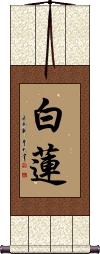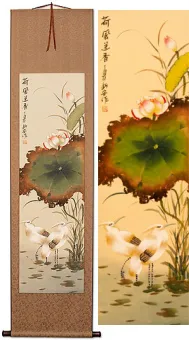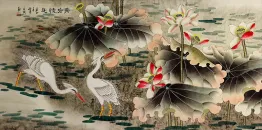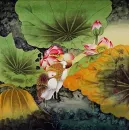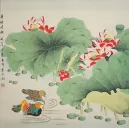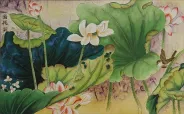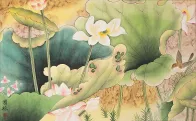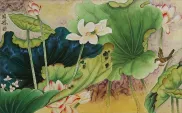Many custom options...
And formats...

Lotus Heart in Chinese / Japanese...
Buy a Lotus Heart calligraphy wall scroll here!
White Lotus
白蓮 is the title for the white lotus (flower) or a short name for the White Lotus society.
The white lotus represents purity or a pure heart and is often associated with Buddhism.
Notes: This can be the Japanese given name Byakuren. In the Buddhist context, the white lotus represented by these characters is originally puṇḍarīka in Sanskrit.
This in-stock artwork might be what you are looking for, and ships right away...
Gallery Price: $108.00
Your Price: $59.88
Gallery Price: $340.00
Your Price: $188.88
Gallery Price: $304.00
Your Price: $168.88
Gallery Price: $60.00
Your Price: $36.88
Gallery Price: $126.00
Your Price: $69.88
Gallery Price: $60.00
Your Price: $36.88
Gallery Price: $90.00
Your Price: $49.88
Gallery Price: $300.00
Your Price: $128.88
Gallery Price: $60.00
Your Price: $36.88
Gallery Price: $353.00
Your Price: $195.88
Gallery Price: $353.00
Your Price: $195.88
Gallery Price: $353.00
Your Price: $195.88
Not the results for lotus heart that you were looking for?
Below are some entries from our dictionary that may match your lotus heart search...
| Characters If shown, 2nd row is Simp. Chinese |
Pronunciation Romanization |
Simple Dictionary Definition |
心 see styles |
xīn xin1 hsin haato / hato ハート |
More info & calligraphy: Heart / Mind / Spirit(1) (See 心・こころ・1) heart; mind; spirit; vitality; inner strength; (2) bottom of one's heart; core (of one's character); nature; (3) (usu. written as 芯) (See 芯・2) centre; center; core; heart; (4) (See 心臓・1) heart (organ); (5) {astron} (See 二十八宿) Chinese "Heart" constellation (one of the 28 mansions); (6) (archaism) (child. language) friend; (given name) Haato hṛd, hṛdaya 汗栗太 (or 汗栗馱); 紀哩馱 the heart, mind, soul; citta 質多 the heart as the seat of thought or intelligence. In both senses the heart is likened to a lotus. There are various definitions, of which the following are six instances: (1) 肉團心 hṛd, the physical heart of sentient or nonsentient living beings, e. g. men, trees, etc. (2) 集起心 citta, the ālayavijñāna, or totality of mind, and the source of all mental activity. (3) 思量心 manas, the thinking and calculating mind; (4) 緣慮心; 了別心; 慮知心; citta; the discriminating mind; (5) 堅實心 the bhūtatathatā mind, or the permanent mind; (6) 積聚精要心 the mind essence of the sutras. |
白蓮 白莲 see styles |
bái lián bai2 lian2 pai lien byakuren びゃくれん |
More info & calligraphy: White Lotus(1) white lotus; (2) purity; pure heart; (given name) Byakuren (白蓮華); 分陀利 puṇḍarīka, the white lotus. |
九尊 see styles |
jiǔ zūn jiu3 zun1 chiu tsun kuson |
The nine honoured ones in the eight-petalled hall of the Garbhadhātu, i.e. Vairocana in the centre of the lotus, with four Buddhas and four bodhisattvas on the petals, the lotus representing the human heart; v. 五佛. |
內心 内心 see styles |
nèi xīn nei4 xin1 nei hsin naishin |
heart; innermost being; (math.) incenter The mind or heart within; the red lotus is used in the 大日經 as its emblem. |
心蓮 心莲 see styles |
xīn lián xin1 lian2 hsin lien Shinren |
The lotus of the mind or heart; the exoteric school interprets it by original purity; the esoteric by the physical heart, which resembles a closed lotus with eight petals. |
蓮宮 莲宫 see styles |
lián gōng lian2 gong1 lien kung hasumiya はすみや |
(place-name) Hasumiya padmavimāna. Lotus-palace, the Pure Land of the saṃbhogakāya; also the eight-leaved lotus of the heart. |
蓮胎 莲胎 see styles |
lián tāi lian2 tai1 lien t`ai lien tai rentai |
The Lotus-womb in which the believers of Amitābha are born into his paradise; it is also described as the believer's heart in embryo. |
身蓮 身莲 see styles |
shēn lián shen1 lian2 shen lien shinren |
The lotus in the body, i. e. the heart, or eight-leaved lotus in all beings; it represents also the Garbhadhātu, which is the matrix of the material world out of which all beings come. |
八葉院 八叶院 see styles |
bā shě yuàn ba1 she3 yuan4 pa she yüan hachishōin |
is the central court of the 胎藏界with Vairocana as its central figure, also termed 八葉蓮臺 or 八葉座 An esoteric name for the heart is the eight-petal fleshly heart, and being the seat of meditation it gives rise to the term eight-leaf lotus meditation. |
月輪觀 月轮观 see styles |
yuè lún guān yue4 lun2 guan1 yüeh lun kuan gatsurinkan |
(or 月輪三昧) The moon contemplation ( or samādhi) in regard to its sixteen nights of waxing to the full, and the application of this contemplation to the development of bodhi within, especially of the sixteen kinds of bodhisattva mind of the lotus and of the human heart. |
胎藏界 see styles |
tāi zàng jiè tai1 zang4 jie4 t`ai tsang chieh tai tsang chieh taizō kai |
Garbhadhātu, or Garbhakośa-(dhātu), the womb treasury, the universal source from which all things are produced; the matrix; the embryo; likened to a womb in which all of a child is conceived— its body, mind, etc. It is container and content; it covers and nourishes; and is the source of all supply. It represents the 理性 fundamental nature, both material elements and pure bodhi, or wisdom in essence or purity; 理 being the garbhadhātu as fundamental wisdom, and 智 acquired wisdom or knowledge, the vajradhātu. It also represents the human heart in its innocence or pristine purity, which is considered as the source of all Buddha-pity and moral knowledge. And it indicates that from the central being in the maṇḍala, viz. the Sun as symbol of Vairocana, there issue all the other manifestations of wisdom and power, Buddhas, bodhisattvas, demons, etc. It is 本覺 original intellect, or the static intellectuality, in contrast with 始覺 intellection, the initial or dynamic intellectuality represented in the vajradhātu; hence it is the 因 cause and vajradhātu the 果 effect; though as both are a unity, the reverse may be the rule, the effect being also the cause; it is also likened to 利他 enriching others, as vajradhātu is to 自利 enriching self. Kōbō Daishi, founder of the Yoga or Shingon 眞言 School in Japan, adopted the representation of the ideas in maṇḍalas, or diagrams, as the best way of revealing the mystic doctrine to the ignorant. The garbhadhātu is the womb or treasury of all things, the universe; the 理 fundamental principle, the source; its symbols are a triangle on its base, and an open lotus as representing the sun and Vairocana. In Japan this maṇḍala is placed on the east, typifying the rising sun as source, or 理. The vajradhātu is placed west and represents 智 wisdom or knowledge as derived from 理 the underlying principle, but the two are essential one to the other, neither existing apart. The material and spiritual; wisdom-source and intelligence; essence and substance; and similar complementary ideas are thus portrayed; the garbhadhātu may be generally considered as the static and the vajradhātu as the dynamic categories, which are nevertheless a unity. The garbhadhātu is divided into 三部 three sections representing samādhi or quiescence, wisdom-store, and pity-store, or thought, knowledge, pity; one is called the Buddha-section, the others the Vajra and Lotus sections respectively; the three also typify vimokṣa, prajñā, and dharmakāya, or freedom, understanding, and spirituality. There are three heads of these sections, i. e. Vairocana, Vajrapāṇi, and Avalokiteśvara; each has a mother or source, e. g. Vairocana from Buddha's-eye; and each has a 明王 or emanation of protection against evil; also a śakti or female energy; a germ-letter, etc. The diagram of five Buddhas contains also four bodhisattvas, making nine in all, and there are altogether thirteen 大院 or great courts of various types of ideas, of varying numbers, generally spoken of as 414. Cf. 金剛界; 大日; 兩部. |
大悲胎藏 see styles |
dà bēi tāi zàng da4 bei1 tai1 zang4 ta pei t`ai tsang ta pei tai tsang daihi taizō |
The womb―store of great pity, the fundamental heart of bodhi in all: this womb is likened to a heart opening as an eight-leaved lotus, in the center being Vairocana, the source of pity. |
中臺八葉院 中台八叶院 see styles |
zhōng tái bā shě yuàn zhong1 tai2 ba1 she3 yuan4 chung t`ai pa she yüan chung tai pa she yüan chūdai hachiyō in |
The Court of the eight-petaled lotus in the middle of the Garbhadhātu, with Vairocana in its center and four Buddhas and four bodhisattvas on the eight petals. The lotus is likened to the human heart, with the Sun-Buddha 大日 at its center. The four Buddhas are E. Akṣobhya, S. Ratnasambhava, W. Amitābha, N. Amoghasiddhi; the four bodhisattvas are S. E. Samantabhadra, S. W. Mañjuśrī, N. W. Avalokiteśvara, and N. E. Maitreya. |
九字曼荼羅 九字曼荼罗 see styles |
jiǔ zì màn tú luó jiu3 zi4 man4 tu2 luo2 chiu tzu man t`u lo chiu tzu man tu lo kuji mandara |
The nine character maṇḍala, i.e. the lotus, with its eight petals and its centre; Avalokiteśvara may be placed in the heart and Amitābha on each petal, generally in the shape of the Sanskrit "seed" letter, or alphabetic letter. |
內心曼荼羅 内心曼荼罗 see styles |
nèi xīn màn tú luó nei4 xin1 man4 tu2 luo2 nei hsin man t`u lo nei hsin man tu lo naishin mandara |
(or 祕密曼荼羅) The 'central heart ' maṇḍala of the 大日經 or the central throne in the diamond realm lotus to which it refers. |
The following table may be helpful for those studying Chinese or Japanese...
| Title | Characters | Romaji (Romanized Japanese) | Various forms of Romanized Chinese | |
| White Lotus | 白蓮 白莲 | byakuren | bái lián / bai2 lian2 / bai lian / bailian | pai lien / pailien |
| In some entries above you will see that characters have different versions above and below a line. In these cases, the characters above the line are Traditional Chinese, while the ones below are Simplified Chinese. | ||||
Successful Chinese Character and Japanese Kanji calligraphy searches within the last few hours...
